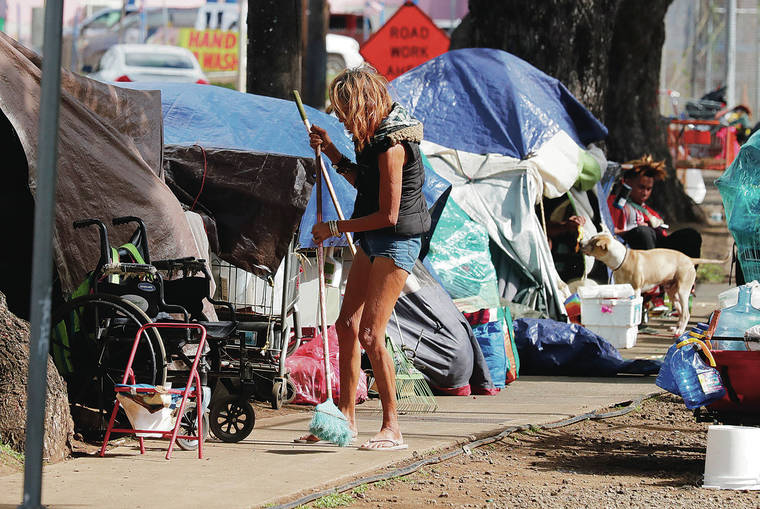
JAMM AQUINO / JAQUINO@STARADVERTISER.COM
A homeless encampment could be seen Tuesday on Dillingham Boulevard.
Hawaii no longer holds the ignominious title as the country’s leading state in per capita homelessness.
We’re now No. 2.
That’s the word from Scott Morishige, the state’s homeless coordinator, who told state lawmakers Tuesday that New York has taken over the top spot, in part because Hawaii’s situation has improved.
“We’re not quite out of the woods yet, but we have shown progress,” Morishige said.
The remarks were made at the Hawaii Homelessness Summit, a joint conference of both houses of the state Legislature designed to help lawmakers evaluate the success of programs funded by the Legislature and to look at other solutions to homelessness.
In 2018 the Legislature allotted $30 million for six “Ohana Zones” across the state providing temporary housing along with social and health services that aim to transition homeless folks to affordable housing. Gov. David Ige began releasing funding for Ohana Zone projects last year.
During Tuesday’s 2-1/2-hour summit, government officials and service providers from across the state described their work and the progress their agencies are making.
Morishige said placements of homeless folks into permanent housing increased dramatically in 2018, from nearly 4,000 to over 7,000. And, he said, it appears the state exceeded 7,000 placements for a second year in a row in 2019.
After trending upward from 2013 to 2016, Hawaii’s official Point in Time count of homeless people experienced an overall decrease over the past four years. The decrease corresponds with similar increases in housing placements over the same period and is reflected in other homelessness-related surveys, Morishige said.
A key bright spot: There has been a nearly 40% reduction in homeless families with minor children since 2016.
Marc Alexander, executive director of Honolulu Mayor Kirk Caldwell’s housing office, said the city has made progress by focusing on housing and support services.
“You don’t eliminate homelessness unless you provide housing for people. More shelters does not do the trick,” he said.
Alexander said unsheltered homeless are the most vulnerable people in the community. According to the Honolulu medical examiner, there were 90 deaths in 2018 with an average age under 53 years of age. As of late December there were 104 homeless deaths in 2019.
“To leave them on the streets is simply unconscionable. We cannot allow that to happen,” he said.
Alexander said the various layers of government and service providers must work together to make further progress.
“You cannot do this alone,” he said. “We gotta check the egos. We gotta know that the only way we’re going to help those who are most vulnerable in the larger community is by us all working together.”
Lt. Gov. Josh Green gave a pitch for developing villages of tiny houses. The kauhale, as they are called, are “the missing link” to the state’s homeless problem, he said.
The idea was borrowed from a similar project in Austin, Texas, Green said, and would mean transferring unused state land to the Hawaii Housing Authority and then bringing together builders and donors to quickly create communities of tiny homes for chronically homeless adults.
“It can be done very inexpensively as compared to almost any other project, because we use state land,” the lieutenant governor said. “And we have a ton of private-sector support willing to pay for as much as half of it.”
Brandee Menino, chairwoman of Bridging the Gap, said state lawmakers would do well to find solutions to the issues that cause people to fall into homelessness.
“We’re expected to be mental health experts, substance abuse experts, housing experts, immigration experts, judiciary criminal justice experts. But why are we expected to be those experts when there are other systems that should be addressing these?” she said.
Menino, CEO of Hope Services Hawaii of Hilo, said that while officials are making progress moving the homeless into permanent housing, more people seem to be falling into homelessness. She said 70% of the people her agency served last year were new to being homeless.
“That’s why (the problem) keeps looking like it’s the same,” she said.
THE VULNERABLE HOMELESS IN HONOLULU
>> There were 90 deaths in 2018 with an average age of under 53.
>> There were at least 104 deaths in 2019.
Source: Honolulu medical examiner
Read the article direct through the Honolulu Star-Advertiser here.
